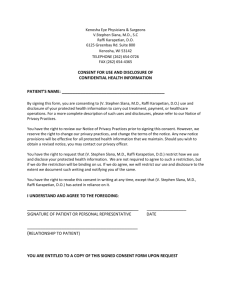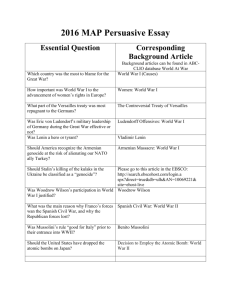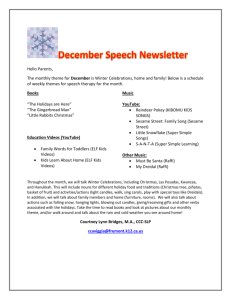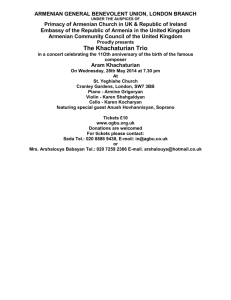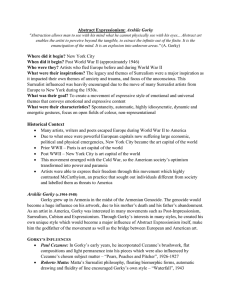Ararat
advertisement
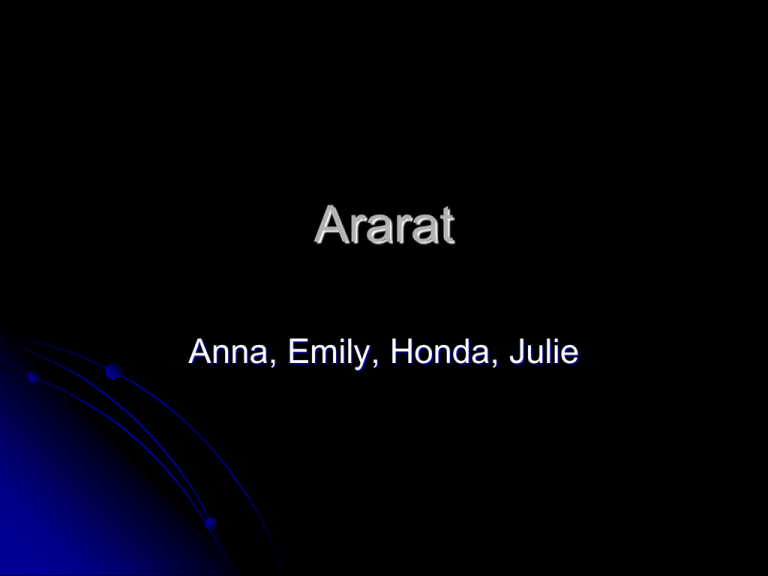
Ararat Anna, Emily, Honda, Julie Outline I. II. III. Introduction A. Armenian genocide B. Atom Egoyan C. Structure D. Theme Analysis A. Characters B. Parallel—family relation 1. Ani & Raffi 2. Gorky & his mother 3. David & Philip C. Trauma 1. Personal trauma 2. Historical trauma D. Retelling history E. Symbol Conclusion Introduction Armenian genocide (1915-1917 / WWI) Armenians became the only major Christian minority and call for independence Turks killed millions of Armenians Historical, cultural and political conditions led to this tragedy Turkey denies the word “genocide” and gives some excuses Ararat Tragic historical event, Turkey in denial, people yearning for the truth An Armenian director makes a film in Toronto to represent the tragic history From the fictional point of view of a genuine historical figure, Gorky Film named “Ararat” same as the movie Atom Egoyan (1960) Atom Egoyan (1960) Director of Ararat Armenian-Canadian (Born in Egypt, immigrate to Victoria, British Columbia ) Son of Armenian refugees Director, writer, editor, and producer Quotation “You can talk about Holocaust denial, but it's really marginal for the most part. What is compelling about the Armenian genocide, is how it has been forgotten.” -Atom Egoyan Atom Egoyan Experience Reject his own ethnicity and reject to learn native language until college Begin to recognize Armenian identity/culture issue ex. Next of Kin, Calendar, Ararat “Atom” He was named “Atom” to mark the completion of Egypt's first nuclear reactor His parents expect him to be like an “atom” to influence people Structure Framed as scenes Film-within-the-film Theme Historical trauma Family relation Characters Ani An art historian and expert on Gorky Adviser on Saroyan's fictional film Raffi’s mother Raffi Interrogated by Canada custom when he back from Turkey Celia Raffi’s step-sister / crazy girlfriend who believes that Ani kills her father Edward Saroyan Director of the Ararat in the film-within-the-film His mother died in genocide Gorky Armenian refugee painter / boy in the painting Ali Turkish-Canadian actor Playing an evil Turkish military officer in Saroyan's film. David Canadian customs officer Interrogated Raffi whose son (Philip) is having a homosexual relationship with Ali Family Relation Ani & Raffi (1) The poem (foreshadowing) Different interpretation between Ani & Raffi. The girl is crazy/angry. A voyage of seeking passion. Taken out the heart, her mother says “my poor boy, did you hurt yourself.” Ani & Raffi (2) Raffi tries to find his origin (a voyage.) Through parents Making film for both Ani and himself. Origin of what? Painting – sketch – photograph – art work. media Through camera and art work. The representation of the origin. A connection with the past. From history to the present. Gorky & his mother Where Ani and Raffi’s relation extend Ani was projected that Raffi would leave her Projection not necessarily would cause confusion. Gorky Develops sentiments through the process of drawing. A connection with the past. Repetition Pencil -> oil -> erase. David & Philip (1) As a Customs officer. (Value system) Superintend Subjects simply as figures. Pomegranate (film-maker.) Value system Could understand what is tangible, but not feeling. David & Philip (2) Lover Ali Philip The issue brought by “Amen.” Toni Issue David Religion, gender, and race. Christianity. Homosexual. David & Philip (3) Raffi Raffi telling David his story. Influence David buys it David Tolerance Let him go, without punishment. Reminds him of Philip. Develops tolerance Philip Through Words, tapes, journal. Cans of film=heroin. Issue between Philip and him. Gender, religion. Trauma The wound only speaks when we look back Freudian Psychoanalytic Theory Defense mechanisms - The purpose of the Ego Defense Mechanisms is to protect the mind/self/ego from anxiety, social sanctions or to provide a refuge from a situation with which one cannot currently cope. Traumatized Characters: Celia & Gorky Celia - death of her father “yours [father] died like a hero, mine died in a stupid accident, according to her [Ani]” blaming Ani: during the lecture, displacement of her trauma “he needed to destroyed what he made” (1:14:10) refusing to believe Ani’s explanation Ani: “Listen, I didn’t see him fall…” (1:16:10) intention to destroy the painting: Displacement Gorky - survivor, witness of the war - the image of mother’s hands - being silent, only communicate with the painting - wiping off his mother’s hands with his hands: from brush to hands - unfinished hands: opened wound - the usage of oil paint: repetition compulsion (18:00/22:40) (16:52/1:25:40) Historical Trauma: Traumatized Armenian People Women being raped - little girl underneath her mother, holding hand in hand German woman (1:23:17) Disgrace of humanity: the war not only kills people but also kills human dignity Retelling History “finding a way to articulate history, identifying what it means to you and what it might mean to others” Film within the film Representation of history/past Clarence Ussher ‘s journal The brutal scenes Gorky in the film a cruel joke a constructed image Ararat/Van poetic license or distortion Authority the camera and the set Raffi and the film initiation to find his origin connection with the past to understand his position/cultural identity Questioning History Twisted, modified Subjective history Ali vs. Raffi and Saroyan Terrorist or freedom fighter (Raffi’s father) ” Every true history is contemporary history” Interpretation The flower on Gorky’s painting A fragrant gift to his absent father Cover the lost bottom Symbols Pomegranate—cultural father Relate to his mother/Armenia Cans emotional items meaningless objects (state apparatus) Mt. Ararat National and religious identity Unfinished hands — open wound Hands Mother’s touch unity Conclusion Button symbolizes “wound” Sewing button Stitch parts and facts together Healing wound Conclusion Did genocide really happen? Armenians Claims: Ottoman Empire committed genocide to the Armenian people, they called it the Armenian Genocide What about Turkey’s stands? Turkey Claims: Deny the word “genocide” During World War I, many Armenians died, but Turks died as well Inter-ethnic violence and the wider conflict of World War I
